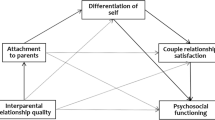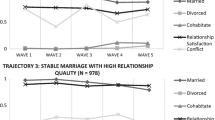Abstract
Interpersonal neurobiology is an interdisciplinary theory that is being used by couple and family therapists. However, more investigation is needed to determine if this theory can accurately explain family relationships over time. In this study, we used the nationally representative National Longitudinal Study of Adolescent to Adult Health (Add Health) dataset to examine key elements of interpersonal neurobiology theory. Using structural equation modeling, we explored how maternal and paternal support and self-acceptance during adolescence are related to emotional stability and adult couple relationship satisfaction 13 years later (N = 7864). Results indicate that self-acceptance and emotional stability are factors that contribute to couple relationship satisfaction. We conclude with clinical implications of this study, including how to use mindfulness practices to promote healthy relationships.

Similar content being viewed by others
References
Arellano, C., & Marlanan, H. (1995). The managing affect and differences scale (MAPS): A self-report measure assessing conflict management in couples. Journal of Family Psychology, 9, 319–334. doi:10.1037/0893-3200.9.3.319.
Barnes, S., Brown, K. W., Krusemark, E., Campbell, W. K., & Rogge, R. D. (2007). The role of mindfulness in romantic relationship satisfaction and responses to relationship stress. Journal of Marital & Family Therapy, 33, 482–500. doi:10.1111/j.1752-0606.2007.00033.x.
Bar-On, R., Tranel, D., Denburg, N. L., & Bechara, A. (2003). Exploring the neurological substrate of emotional and social intelligence. Brain, 126, 1790–1800. doi:10.1093/brain/awg177.
Beaudoin, M.-N., & Zimmerman, J. (2011). Narrative therapy and interpersonal neurobiology: Revisiting classic practices, developing new emphases. Journal of Systemic Therapies, 30(1), 1–13. doi:10.1521/jsyt.2011.30.1.1.
Ben-Ari, A., & Lavee, Y. (2005). Dyadic characteristics of individual attributes: attachment, neuroticism, and their relation to marital quality and closeness. The American Journal of Orthopsychiatry, 75, 621–631. doi:10.1037/0002-9432.75.4.621.
Bowlby, J. (1988). A secure base: Parent-child attachment and healthy human development. New York: Basic Books.
Carson, J. W., Carson, K. M., Gil, K. M., & Baucom, D. H. (2004). Mindfulness-based relationship enhancement. Behavior Therapy, 35, 471–494. doi:10.1016/S0005-7894(04)80028-5.
Chamberlain, J. M., & Haaga, D. A. F. (2001). Unconditional self-acceptance and psychological health. Journal of Rational-Emotive & Cognitive-Behavior Therapy, 19, 163–176. doi:10.1023/A:1011189416600.
Cordova, J. V., Gee, C. B., & Warren, L. Z. (2005). Emotional skillfulness in marriage: Intimacy as a mediator of the relationship between emotional skillfulness and marital satisfaction. Journal of Social and Clinical Psychology, 24, 218–235. doi:10.1521/jscp.24.2.218.62270.
Costa, P. T., & McCrae, R. R. (1980). Influence of extraversion and neuroticism on subjective well-being: Happy and unhappy people. Journal of Personality and Social Psychology, 38(4), 668–678. doi:10.1037/0022-3514.38.4.668.
Coyne, J. (2013). Parenting from the outside-in: Reflections on parent training during a potential paradigm shift. Australian Psychologist, 48, 379–387. doi:10.1111/ap.12010.
Davidson, R. J., Jackson, D. C., & Kalin, N. H. (2000). Emotion, plasticity, context, and regulation: Perspectives from affective neuroscience. Psychological Bulletin, 126, 890–909. doi:10.1037/0033-2909.126.6.890.
DeCarlo, L. T. (1997). On the meaning and use of kurtosis. Psychological Methods, 2, 292–307. doi:10.1037/1082-989X.2.3.292.
Denissen, J. J. A., & Penke, L. (2008). Neuroticism predicts reactions to cues of social inclusion. European Journal of Personality, 22, 497–517. doi:10.1002/per.682.
Dumas, J. E. (2005). Mindfulness-based parent training: Strategies to lessen the grip of automaticity in families with disruptive children. Journal of Clinical Child and Adolescent Psychology, 34, 779–791. doi:10.1207/s15374424jccp3404_20.
Duncan, L. G., Coatsworth, J. D., & Greenberg, M. T. (2009). A model of mindful parenting: Implications for parent-child relationships and prevention research. Child Clinical and Family Psychology Review, 12, 225–270. doi:10.1007/s10567-009-0046-3.
Fishbane, M. D. (2007). Wired to connect: Neuroscience, relationships, and therapy. Family Process, 46, 395–412. doi:10.1111/j.1545-5300.2007.00219.x.
Gambrel, L. E., & Keeling, M. L. (2010). Relational aspects of mindfulness: Implications for the practice of marriage and family therapy. Contemporary Family Therapy: An International Journal, 32, 412–426. doi:10.1007/s10591-010-9129-z.
Gambrel, L. E., & Piercy, F. P. (2014). Mindfulness-based relationship education for couples expecting their first child—part 1: A randomized mixed-methods program evaluation. Journal of Marital and Family Therapy, 41, 5–24. doi:10.1111/jmft.12066.
Gardner, B. C., Busby, D. M., Burr, B. K., & Lyon, S. E. (2011). Getting to the root of relationship attributions: Family-of-origin perspectives on self and partner views. Contemporary Family Therapy, 33, 253–272. doi:10.1007/s10591-011-9163-5.
Gillespie, B., Davey, M. P., & Flemke, K. (2015). Intimate partners’ perspectives on the relational effects of mindfulness-based stress reduction training: A qualitative research study. Contemporary Family Therapy, OnlineFirst.,. doi:10.1007/s10591-015-9350-x.
Gottman, J. G., & Gottman, J. S. (2008). And baby makes three: The six-step plan for preserving marital intimacy and rekindling romance after baby arrives. New York: Three Rivers Press.
Gottman, J. M., & Levenson, R. W. (1992). Marital processes predictive of later dissolution: Behavior, physiology, and health. Journal of Personality and Social Psychology, 63, 221–233. doi:10.1037/0022-3514.63.2.221.
Harris, K. M., Halpern, C.T., Whitsel, E., Hussey, J., Tabor, J., Entzel, P., & Udry, J. R. (2009). The national longitudinal study of adolescent to adult health: Research design [WWW document]. http://www.cpc.unc.edu/projects/addhealth/design
Hawkins, D., & Booth, A. (2005). Unhappily ever after effects of long-term, low-quality marriages on well-being. Social Forces, 84, 445–465. doi:10.1353/sof.2005.0103.
Hawks, J. M., Parker, T. S., Werner-Wilson, R., Huff, N., & Lianekhammy, J. (2015). Adolescents’ and parents’ expression of empathy: A social neuroscience perspective. Contemporary Family Therapy, 37(142–152), 2005. doi:10.1007/s10591-015-9334-x.
Hodgson, J. L., Johnson, L. N., Ketring, S. A., Wampler, R. S., & Lamson, A. L. (2005). Integrating research and clinical training in marriage and family therapy training programs. Journal of Marital and Family Therapy, 31, 75–88. doi:10.1111/j.1752-0606.2005.tb01544.x.
Hu, L., & Bentler, P. M. (1999). Cutoff criteria for fit indexes in covariance structure analysis: Conventional criteria versus new alternatives. Structural Equation Modeling, 6, 1–55. doi:10.1080/10705519909540118.
Kahn, G. B., & Feldman, D. B. (2011). Relationship-focused group therapy (RFGT) to mitigate marital instability and neuropsychophysiological dysregulation. International Journal of Group Psychotherapy, 61, 519–536. doi:10.1521/ijgp.2011.61.4.518.
Kamp Dush, C. M., Taylor, M. G., & Kroeger, R. A. (2008). Marital happiness and psychological well-being across the life course. Family Relations, 57, 211–226. doi:10.1111/j.1741-3729.2008.00495.x.
Kernis, M. H. (2003). Toward a conceptualization of optimal self-esteem. Psychological Inquiry, 14, 1–26. doi:10.1207/S15327965PLI1401_01.
Kiecolt-Glaser, J. K., Glaser, R., Cacioppo, J. T., & Malarkey, W. B. (1998). Marital stress: Immunologic, neuroendocrine, and autonomic correlates. Annals of the New York Academy of Sciences, 840, 656–663. doi:10.1111/j.1749-6632.1998.tb09604.x.
Kline, R. B. (2005). Principles and practice of structural equation modeling (2nd ed.). New York: Guilford.
Larner, G. (2004). Family therapy and the politics of evidence. Journal of Family Therapy, 26, 17–39. doi:10.1111/j.1467-6427.2004.00265.x.
Lindahl, K., & Markman, H. J. (1990). Communication and negative affect regulation in the family. In E. Blechrnan (Ed.), Emotions and families (pp. 99–116). New York: Plenum Press.
Little, R. J. A., & Rubin, D. B. (2002). Statistical analysis with missing data (2nd ed.). Hoboken, NJ: Wiley.
Liu, D., Diorio, J., Tannenbaum, B., Caldji, C., Francis, D., Freedman, A., & Meaney, M. J. (1997). Maternal care, hippocampal glucocorticoid receptors, and hypothalamic-pituitary-adrenal responses to stress. Science, 277, 1659–1662. doi:10.1126/science.277.5332.1659.
Luby, J. L., Barch, D. M., Belden, A., Gaffrey, M. S., Tillman, R., Babb, C., et al. (2012). Maternal support in early childhood predicts larger hippocampal volumes at school age. Proceedings of the National Academy of Sciences, 109(8), 2854–2859. doi:10.1073/pnas.1118003109.
Macinnes, D. L. (2006). Self-esteem and self-acceptance: An examination into their relationship and their effect on psychological health. Journal of Psychiatric and Mental Health Nursing, 13, 483–489. doi:10.1111/j.1365-2850.2006.00959.x.
Malouff, J. M., Thorsteinsson, E. B., Schutte, N. S., Bhullar, N., & Rooke, S. E. (2010). The five-factor model of personality and relationship satisfaction of intimate partners: A meta-analysis. Journal of Research in Personality, 44, 124–127. doi:10.1016/j.jrp.2009.09.004.
Muthén, L. K., & Muthén, B. O. (2007). Mplus user’s guide (5th ed.). Los Angeles, CA: Muthén & Muthén.
Nitschke, J. B., Nelson, E. E., Rusch, B. D., Fox, A. S., Oakes, T. R., & Davidson, R. J. (2004). Orbitofrontal cortex tracks positive mood in mothers viewing pictures of their newborn infants. Neuroimage, 21, 583–592. doi:10.1016/j.neuroimage.2003.10.005.
Pruit, I. T., & McCollum, E. E. (2010). Voices of experienced meditators: The impact of meditation practice on intimate relationships. Contemporary Family Therapy, 32, 135–154. doi:10.1007/s10591-009-9112-8.
Robles, T. F., & Kiecolt-Glaser, J. K. (2003). The physiology of marriage: Pathways to health. Physiology & Behavior, 79, 409–416. doi:10.1016/S0031-9384(03)00160-4.
Rosenblum, L. A., Coplan, J. D., Friedman, S., Bassoff, T., Gorman, J. M., & Andrews, M. W. (1994). Adverse early experiences affect noradrenergic and serotonergic functioning in adult primates. Biological Psychiatry, 35, 221–227. doi:10.1016/0006-3223(94)91252-1.
Siegel, D. J. (1999). The developing mind: How relationships and the brain interact to shape who we are. New York: Guilford.
Siegel, D. J. (2006). An interpersonal neurobiology approach to psychotherapy. Psychiatric Annals, 36, 248–256. http://www.healio.com/psychiatry/journals/psycann/2006-4-36-4
Siegel, D. J. (2007). The mindful brain. New York: W.W. Norton.
Siegel, D. J. (2010). The mindful therapist: A clinician’s guide to mindsight and neural integration. New York: W. W. Norton.
Siegel, D. J. (2012). The developing mind: How relationships and the brain interact to shape who we are (2nd ed.). New York: Guilford.
Siegel, D. J., & Hartzell, M. (2003). Parenting from the inside out: How a deeper self-understanding can help you raise children who thrive. New York: Penguin.
Sluzki, C. E. (2007). Interfaces: Toward a new generation of systemic models in family research and practice. Family Process, 46, 173–184. doi:10.1111/j.1545-5300.2007.00202.x.
Tennen, H., & Affleck, G. (1993). The puzzles of self-esteem: A clinical perspective. In R. F. Baumeister (Ed.), Self-esteem: The puzzle of low self-regard (pp. 37–54). New York: Plenum.
Tootle, A. E. (2003). Neuroscience applications in marital and family therapy. The Family Journal, 11, 185–190. doi:10.1177/1066480702250168.
Umberson, D., Williams, K., Powers, D. A., Liu, H., & Needham, B. (2006). You make me sick: Marital quality and health over the life course. Journal of Health and Social Behavior, 47, 1–16. doi:10.1177/002214650604700101.
Wachs, K., & Cordova, J. V. (2007). Mindful relating: Exploring mindfulness and emotion repertoires in intimate relationships. Journal of Marital & Family Therapy, 33, 464–481. doi:10.1111/j.1752-0606.2007.00032.x.
Windsor, T. D., Ryan, L. H., & Smith, J. (2009). Individual well-being in middle and older adulthood: Do spousal beliefs matter? Journals of Gerontology Series B-Psychological Sciences and Social Sciences, 64, 586–596. doi:10.1093/geronb/gbp058.
Acknowledgments
This research uses data from Add Health, a program project directed by Kathleen Mullan Harris and designed by J. Richard Udry, Peter S. Bearman, and Kathleen Mullan Harris at the University of North Carolina at Chapel Hill, and funded by Grant P01-HD31921 from the Eunice Kennedy Shriver National Institute of Child Health and Human Development, with cooperative funding from 23 other federal agencies and foundations. Special acknowledgment is due Ronald R. Rindfuss and Barbara Entwisle for assistance in the original design. Information on how to obtain the Add Health data files is available on the Add Health website (http://www.cpc.unc.edu/addhealth). No direct support was received from Grant P01-HD31921 for this analysis.
Author information
Authors and Affiliations
Corresponding author
Rights and permissions
About this article
Cite this article
Gambrel, L.E., Faas, C., Kaestle, C.E. et al. Interpersonal Neurobiology and Couple Relationship Quality: A Longitudinal Model. Contemp Fam Ther 38, 272–283 (2016). https://doi.org/10.1007/s10591-016-9381-y
Published:
Issue Date:
DOI: https://doi.org/10.1007/s10591-016-9381-y




